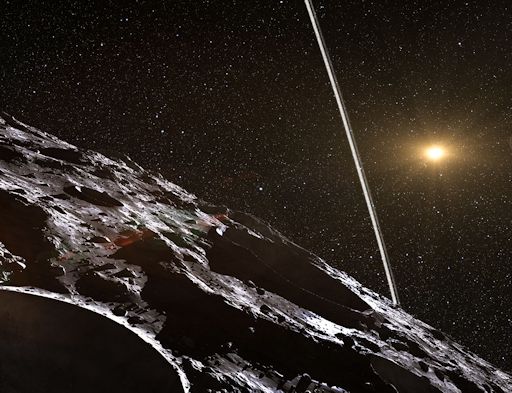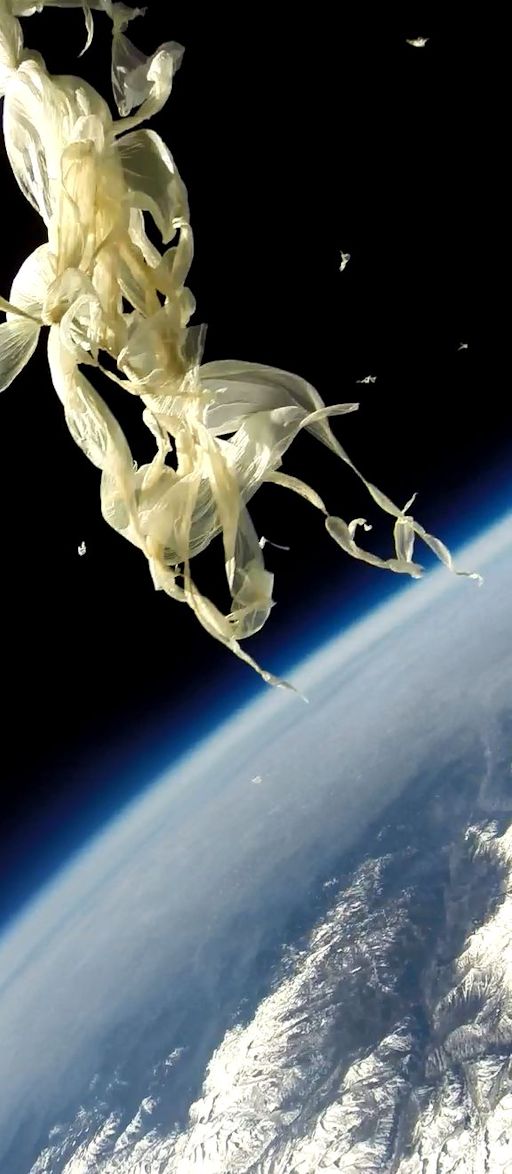When is the best time to see auroras? Where is the best place to go? And how do you photograph them? These questions and more are answered in a new book, Northern Lights - a Guide, by Pal Brekke & Fredrik Broms. | | |
STRANGE BUT TRUE--AN ASTEROID WITH RINGS: Today at a press conference in Brazil, astronomers announced the surprising discovery of an asteroid with rings. The 250-km-wide asteroid, named Chariklo, is located in the outer solar system between Saturn and Uranus. In June 2013, observers used seven different telescopes in South America to watch the asteroid pass in front of a distant star. The star winked out not just once, as would be expected for a solitary asteroid, but multiple times, revealing a pair of dense narrow rings surrounding the space rock. Here is an artist's concept of the system:

"We weren't looking for a ring and didn't think small bodies like Chariklo had them at all, so the discovery — and the amazing amount of detail we saw in the system — came as a complete surprise!" says Felipe Braga-Ribas of Observatório Nacional/MCTI in Rio de Janeiro. He planned the observing campaign and is the lead author of a March 26th paper in Nature describing the results.
According to their analysis, the rings are only 3 km and 7 km wide, respectively, with a 9 km gap between them. "I try to imagine how it would be to stand on the surface of this icy asteroid and stare up at a such a ring system 1000 times closer than the Moon," adds team member Uffe Gråe Jørgensen of the Niels Bohr Institute in Denmark.
Because the rings are so narrow, they are probably confined and shepherded by small satellites. "So, as well as the rings, it's likely that Chariklo has at least one small moon still waiting to be discovered," adds Felipe Braga Ribas. For more information about this discovery, click here.
WEAK IMPACT, AURORAS ANYWAY: A CME hit Earth's magnetic field on March 25th at approximately 19:45 UT. The glancing blow was relatively weak, but auroras appeared anyway. Hours after the impact, green lights dueled with the blue glow of dawn over Sørkjosen, Norway:

"The sky was really bright at 3am, but I could still see the auroras," says photographer Tommy Richardsen. "Times around equinoxes really are special. You can see auroras even when you should not be able to."
He's right. For reasons researchers do not fully understand, equinoxes favor auroras. As northern spring unfolds, even relatively small gusts of solar wind and weak CME impacts can spark a good display. NOAA forecasters estimate a 40% chance of geomagnetic storms on March 26th as Earth passes through the wake of the CME. Aurora alerts: text, voice
Realtime Aurora Photo Gallery
OBJECT AT THE EDGE OF SPACE: On March 16th, a strangely-shaped object was photographed 92,000 feet above Earth's surface. Can you guess what it is? Scrutinize the image, then scroll down for the answer:

It's a tangled wad of natural rubber, the remains of a suborbital helium research balloon that popped approximately 2 seconds before the photo was taken. Regular readers might have already guessed that the picture was taken by the Space Weather Rapid Response (SWxRR) Payload launched to the stratosphere on March 16th by the students of Earth to Sky Calculus. This is just one of many spectacular pictures captured during the two-hour flight to the edge of space.
SWxRR is an experimental payload that can be launched to the edge of space with minimal delay in response to fast-developing or unexpected space weather events. It contains cameras, a cryogenic thermometer, a GPS altimeter, and a 10.0 KeV to 20.0 MeV radiation counter to measure the effect of solar storms on Earth's upper atmosphere. Ultimately, as techniques are improved, we hope to be able to sample the radiation content of the atmosphere and report results to readers while storms are in progress. Data from the March 16th flight are being analyzed now.
Realtime Space Weather Photo Gallery
Realtime Mars Photo Gallery
Realtime Comet Photo Gallery
Every night, a network of NASA all-sky cameras scans the skies above the United States for meteoritic fireballs. Automated software maintained by NASA's Meteoroid Environment Office calculates their orbits, velocity, penetration depth in Earth's atmosphere and many other characteristics. Daily results are presented here on Spaceweather.com.
On Mar. 26, 2014, the network reported 8 fireballs.
(8 sporadics)

In this diagram of the inner solar system, all of the fireball orbits intersect at a single point--Earth. The orbits are color-coded by velocity, from slow (red) to fast (blue). [Larger image] [movies]
Potentially Hazardous Asteroids (
PHAs) are space rocks larger than approximately 100m that can come closer to Earth than 0.05 AU. None of the known PHAs is on a collision course with our planet, although astronomers are finding
new ones all the time.
On March 26, 2014 there were potentially hazardous asteroids.
Notes: LD means "Lunar Distance." 1 LD = 384,401 km, the distance between Earth and the Moon. 1 LD also equals 0.00256 AU. MAG is the visual magnitude of the asteroid on the date of closest approach. | | The official U.S. government space weather bureau |
| | The first place to look for information about sundogs, pillars, rainbows and related phenomena. |
| | Researchers call it a "Hubble for the sun." SDO is the most advanced solar observatory ever. |
| | 3D views of the sun from NASA's Solar and Terrestrial Relations Observatory |
| | Realtime and archival images of the Sun from SOHO. |
| | from the NOAA Space Environment Center |
| | the underlying science of space weather |

